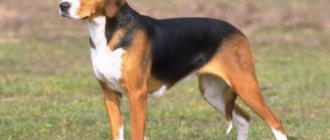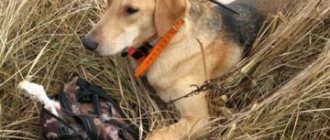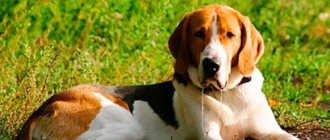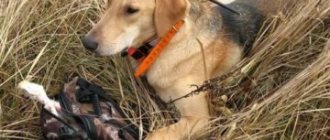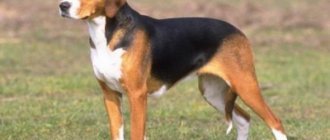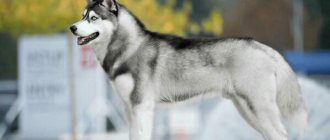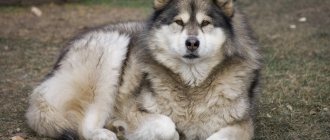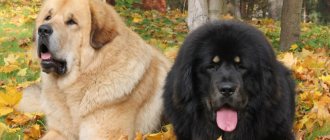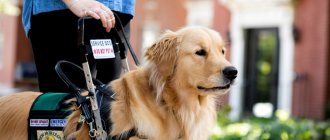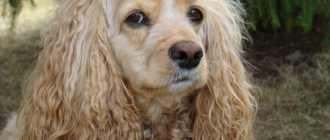History of the Estonian Hound breed
Hound dogs began to be systematically bred in Estonia in the middle of the 18th century. Initially, Russian and Polish hounds were used for selection; at the end of the century before last, hunting dogs from England were imported to the Baltic states. By the 1920s, local hunting dogs became known as Russian-Polish or Russian-English hounds.
Estonian hound
In 1934, new hunting rules were adopted in Estonia, since in the hunting grounds, the territory of which was very small, the number of animals had catastrophically decreased, and the roe deer population was on the verge of extinction. According to the new rules, hunting with dogs was allowed only for small and medium-sized animals, and the height of hounds was limited to 45 cm at the withers. From that time on, work began on the creation of a short hound, which was supposed to retain all the working qualities inherent in a hunting dog. Work on developing a new breed lasted more than 20 years, and it was headed and coordinated by the Estonian dog handler Sergei Smelkov, who rightfully took the pedestal of the creator of the Estonian hound breed.
Initially, the shortest of the local hounds were selected for selection and crossed with the short English hare hound - the beagle. The technique was thoroughly thought out, because not only such a sign of the future breed as short stature was fixed. The English Beagle was also selected for its stout legs, dense and strong paws. These qualities are ideal for Estonian winters with little snow, when hunting trails here often become hard as stone and completely unsuitable for hunting with light-footed dogs. However, such shortcomings of beagles as a cacophonous, rough and muffled voice, the late formation of hunting instincts, and insufficient paratism (the speed with which a dog pursues an animal) prompted Smelkov to also involve the Swiss hound in the creation of a new breed. Although it does not have a sufficiently strong paw, it nevertheless attracted the attention of breeders due to its small stature, excellent viscosity, musical ringing voice and the ability to take up vigorous activity already in the first year of life.
Estonian hound on a walk
It is worth saying that Finnish hounds, English fox hounds, and Russian hounds were also involved in breeding work. By crossing them with standard local hounds, Smelkov intended to separately breed fairly large hunting dogs (52-60 cm). Actually, back in the 40s, the future Estonian hound breed was very diverse, and manifestations of this feature are to some extent sometimes recorded in the animal’s exterior to this day.
In 1947, the USSR Ministry of National Economy took the initiative to oblige each of the fifteen republics to be represented by its own breed of dog. By this time, there were 800-900 hounds in Estonia belonging to the Estonian-English-Swiss breeding line that came out on top. In 1954, 48 individuals typical of this line, tested in hare and fox hunting, passed a specialized commission and were recognized by the USSR Ministry of Agriculture as a separate breed, called the Estonian hound. In 1959, a commission of the USSR Kennel Council approved the breed standard. By the beginning of the eighties, there were 1,750 purebred Estonian hounds in the Soviet Union.
Today, representatives of the original Estonian breed are found mainly in the Baltic countries, Finland, and Russia. Despite the efforts of local dog handlers, the Fédération Cynologique Internationale (FCI) still does not want to recognize the breed. Its standard, approved in 1959, is still valid today, but in 2007 minor changes were made to it regarding the color of the dog.
Character of the Russian hound
The Russian Hound is a hard-working dog with a fairly calm and at the same time strong character. These passionate trackers clearly distinguish between hunting and everyday life, and therefore demonstrate two diametrically opposed lines of behavior. So, for example, in a home environment, the Russian hound transforms into a calm, balanced pet, which cannot be affected even by the most harmful children’s pranks. As a result, you can safely leave the animal to look after the baby, and if you need to leave urgently, turn down the heat on the stove.
Russian hounds only have bad relationships with cats, decorative dogs and other small animals. Like any hunting breed, the RG tends to see prey in every four-legged creature. Hence the race for homeless purrs during walks, as well as constant conflicts with Pekingese, toy terriers and other midgets of the dog world.
Russian hounds are by and large unsuitable for guard work, although they are capable of issuing a good-natured “Woof!” towards an insolent attacker. However, if you remember the size of the breed, such a sluggish attack can also be effective. And yet, acquiring a Russian hound in order to get a devoted watchman is pointless. The only type of activity to which a dog is devoted entirely and completely is hunting. All other duties that any mongrel dog can perform are stubbornly ignored by the hound.
Appearance of the Estonian hound
The Estonian Hound is a muscular dog of small size, lean type of constitution, with solid, strong bones. Her physique is proportional, the length of the body noticeably exceeds the height at the withers. Unlike the squat and downright stocky Beagle, with which the Estonian Hound is often confused, the latter exhibits elegant and graceful features.
Frame
Estonian hound puppy
The line of the back is straight, with a slope from the withers to the sacrum. Both the back and croup are wide and muscular. The voluminous, elongated chest has an oval shape, it is lowered to the elbows and extends to a moderately tucked abdominal wall.
Head
The curved skull is moderately wide, the line of transition to the muzzle looks quite smooth, without a sharp break. The muzzle itself is elongated, straight, proportional to the skull. The brow ridges stand out clearly, but not overly. The nose is wide, fleshy, black in color, its intensity varies with different colors. Lips are dry, not drooping, totally pigmented.
Teeth and jaws
The teeth are white, large, there should be 42 of them. The bite is scissor-shaped, the upper incisors confidently cover the lower ones. As the dog ages, and the incisors wear down, the bite may become straight. The strong jaws of the Estonian Hound are well developed. The cheekbones are lean, without protrusion.
Eyes
The eyes of the Estonian hound are set slightly askew. Their color is dark brown.
Ears
The ears are quite thin, hanging close to the cheeks. Covered with short fur. Their base is located on the eye line. If you extend the ears towards the nose, they will reach approximately the middle of the muzzle. The tips of the ears are noticeably rounded.
Neck
The hound's rounded, muscular neck is of medium length. There are no folds on the skin in the neck area.
Estonian hound muzzle
Limbs
The forelimbs are lean, with well-developed muscles. From the front they look straight and parallel. Their length is approximately half the height of the animal at the withers.
The elbows are strong, close to the body, not protruding either inward or outward. Large, absolutely straight, proportional to the body, the forearms are of medium length. The pasterns are solid, strong, set almost vertically.
The hind limbs of the Estonian hound are powerful, bony, and muscular. From behind they look straight and parallel to each other. The angles of the joints appear clearly. The femurs and tibiae are almost identical in length. The knee joints are strong, with moderate angles. When the dog is in motion, they should not turn in or out. Strong metatarsus of medium length, set vertically.
The paws are arched, elliptical in shape, the toes are closely pressed to each other. The pads and claws directed towards the ground are large and dense.
Movement
Running Estonian hound
The Estonian Hound moves freely, measuredly, plastically, rectilinearly, elastically. The push of the hind limbs is very powerful and confident.
Tail
Thick at the base, covered with thick hair, the tail gradually tapers to the tip, it has a saber shape, reaching the hock joint. When the Estonian Hound moves, the tail should not rise above the line of the back.
Wool
Short, straight, tough, even rough, shiny. The undercoat is very poorly developed.
Color
The characteristic color for the breed is black and piebald on a white background with so-called blush - markings whose color is close to red tan. We also accept brown-piebald color in blush, crimson-piebald, saddleback, looking like a blanket thrown over the back and sides of the dog. The size and shape of the marks may vary, and it is desirable for colors to have maximum intensity. White color should be present on the head, lower parts of the neck, chest, and abdomen. The Estonian Hound's legs and tail tip should be completely white.
Disadvantages of the breed
- Lightness or, on the contrary, heaviness of the dog’s constitution.
- High backside, excessively shortened or elongated torso.
- Too narrow or flat chest, barrel-shaped chest.
- Weak, sagging or hunchbacked back, excessively sloping croup.
- An expressively convex or flattened skull, a sharp or not at all noticeable transition from the forehead to the muzzle. Upturned or downturned muzzle, hooked nose.
- The nose, edges of the lips, and eyelids are not pigmented enough.
- Non-contact bite of incisors.
- Excessively small or bulging eyes, their light color.
- Shortened or excessively fleshy ears, elongated hair on them.
- The vertical position of the neck, the sagging of the skin on it.
- The tail is lowered below the hock joint by more than 3 cm. Short tail, curvature at its tip. Excessive length of hair on the tail, or, on the contrary, scanty coat.
- Elbows turned outwards, hocks. Excessively sloping pasterns, flat or elongated (hare) paws.
- Wavy fur. Excessively long or very short hair on the body, absolute absence of undercoat.
- Cowardice, excessive excitability, aggressiveness.
Appearance of the Russian Hound breed
This is a medium-sized dog with a fairly strong and muscular build. She has a short stature, around 55-68 cm. The appearance of individuals can be assessed from a photo of a Russian hound, where the characteristics of the breed are immediately visible.
Main exterior details:
- The head has a long, wedge-shaped shape. At the same time, it has a pronounced muscular profile, which is a thoroughbred feature of the Russian hound. The forehead is very low, and the skull itself is slightly flattened. At the same time, the teeth are quite massive, and the jaws are very strong.
- The eyes have a bright dark rim and an expressive almond-shaped cut. This gives the dog a very sophisticated look.
- The triangular-shaped ears hang down and are pressed tightly to the head.
- The body has developed muscles and good relief even under the fur. The Russian Hound has a dense and developed chest, a massive back and a strong loin. The belly of these dogs is well-shaped and has developed muscles.
- The paws are placed parallel to each other and, like the rest of the body, have a good muscular structure.
- The tail is slightly thickened at the base. The length reaches the hock joints of the hind legs or may end 1-2 cm above them.
The Russian Hound's coat has an elegant color ranging from light brown to gray. The coat has light tan marks, which adorns the dog. However, dark brown and mousy coat colors are considered a departure from the breed.
Photo of the Estonian hound
Personality of the Estonian Hound
Estonian hound in the arms of its owner
A professional hunter, uncompromising and merciless in the process of baiting the animal, the Estonian hound shows incredible friendliness towards its owners. She leaves her malice and assertiveness outside the threshold of the house, but within its walls she demonstrates an affectionate disposition, complaisance, devotion, patience, and obedience. The good-natured nature of this dog allows it to be kept in a family where children are growing up, as it shows amazing tolerance towards their pranks. Actually, the Estonian hound perceives a family as a pack, where the owner is the leader - she obeys him unquestioningly.
The Estonian hound will live in friendship and harmony with other pets if it grew up with them. If you take an adult dog into your home, you will have to make a lot of effort to eliminate the conflicts that will inevitably arise between four-legged household members, especially if the hound has to get acquainted with a representative of the cat tribe. It is advisable that the owner directly takes charge of establishing friendly relations between the four-legged animals.
A country house is the best place to keep an Estonian hound, but she can also feel quite comfortable in a city apartment if she is given the opportunity to expend her vigorous energy. Otherwise, this dog is unpretentious, and it is also surprisingly clean.
As for hunting, the Estonian hound is quite capable of starting to “work in his specialty” already at six months of age, and some especially talented individuals already at 7-8 months become holders of diplomas received based on the results shown during field tests. When hunting, they pick up a scent very quickly and are able to not miss it for three whole days, or even more. The excitement and aggressiveness shown during work allow these dogs to obtain enviable trophies. Nimbleness, dexterity, and also small stature – these are their advantages in the forest; they quickly and confidently climb through bushes or into dead wood where game is hiding, without giving it a chance to escape.
Despite the fact that the Estonian hound was bred as a hunting dog, thanks to its courage, alertness and intelligence, it also performs excellent guard functions.
Hunting with a Russian hound
The dog's task when hunting is to smell the animal, scare it away and drive it closer to the owner so that he can make an aimed shot. In addition, the Russian hound must use its voice to “inform” the hunter about what kind of prey it has discovered and how the rutting process is going. To do this, the breed skillfully changes the tonality and intensity of its bark, which among its representatives is particularly clear and musical.
The obligatory working qualities of the Russian hound are calliness (instant reaction to the owner’s call), climbing ability (the ability to work in bushes and forest thickets) and endurance (endurance). In particular, a well-trained Russian hound can chase a hare throughout the daylight hours, only occasionally taking short breaks. An important feature of the breed is its viciousness towards the beast. Sitting at home, in an enclosure, the Russian hound is meekness and obedience itself. While hunting, the dog transforms into a cruel and merciless hunter, seeing nothing in front of him except a “living target”. Extremes, however, are also undesirable, so even during an exciting chase, the Russian hound should not lose its mind and become overexcited. Fussiness in movements, nervousness - all this indicates that the animal has not inherited the best working qualities from its ancestors.
According to tradition, they hunt foxes and hares with the Russian hound, although some individuals are able to hunt down larger animals like wild boar or elk. There are two equivalent types of hunting with Russian hounds: stationary and running. In the first case, the hunter stops in a place convenient for making a shot and waits for the dog to start chasing the prey in his direction. In the second, both the hound and the person are constantly moving in search of the beast. By the way, with young individuals who do not have working experience, it is better to practice walking hunting in order to be able to control the pet and correct the mistakes it has made.
Despite the calliness for which the breed is famous, many Russian hounds have problems with returning, that is, the animal gets carried away in pursuit of prey, does not respond to the horn signal and gets lost in the forest. Later, the dog can return to its original position, following its own trail, so in the first hours after the pet disappears, you should not leave the hunting area. Collars with built-in GPS can also help in searching for “lost objects,” although even such electronics do not provide a 100% guarantee that the rescue operation will be successful.
Education and training
The contact and quick-witted Estonian hound is quite easy to train - it grasps all commands on the fly. In addition to standard commands like “Sit!”, “Lie down,” “Give me your paw!”, she must certainly respond to the words “No!”, “Near!” This dog should not be pampered - it will certainly strive to take an independent position, and it will be difficult to wean it from habits such as lying in its owner’s bed and begging. A dog should know its place in the house, but brutal methods in raising it are unacceptable.
Estonian hound on a leash
The future hunter needs to be taught specific skills from puppyhood. Before feeding your pet, sound the hunting horn. As soon as he appears, feed him - this way he will develop a reaction to this calling sound.
If you prepare an Estonian hound puppy for hunting from a tender age, then from the age of seven months he will be able to start working. But experienced owners of dogs of this breed take into account that their childhood is short, and they always approach training with caution - preparing the pet to crawl correctly, detect the animal, drive it away without losing the trail. If you can simply take a two-month-old puppy into the forest with you for familiarization purposes, then a five-month-old dog can already be taught to navigate the terrain and maintain contact with the owner, who may be far from her. Training should be carried out systematically, commands should be practiced sequentially - from simple to complex, lessons should be repeated regularly, reinforcing the desired skills in the animal. During training, it is necessary to monitor the dog: if he is tired, the training should be stopped. Never use rude shouts if the dog is afraid to go into the forest. It is better to start the race with the black trail - this is the name of the autumn land that has not yet had time to be covered with snow.
Attentive, responsible owners do not allow a dog whose age does not exceed one year to work at full capacity, as this can negatively affect its health, especially the functioning of the heart. The Estonian hound can experience full stress when it is 1.5-2 years old.
Raising a dog
This dog is highly intelligent, so raising it is easy and simple. She remembers all the commands the first time and then follows them. At the same time, the animal has a savvy character and quickly navigates independently in difficult situations.
The animal is also very devoted to its owner. After just a few months of communication, the dog begins to feel and understand without the words of its owner.
- A dog is taught hunting skills from 3-4 months, so most often the breeder himself begins to do this.
- That is why hunters always have such a pressing question: where to buy a working Russian hound.
- Breeding Russian hounds prepared for hunting should only be purchased from professional breeders who are members of the International Association of Cynologists.
- Moreover, the price of a Russian hound can range from 20,000 to 70,000 rubles.
During puppyhood, dogs are also taught to restrain their instincts and not immediately rush after prey, but to listen first of all to the owner. Since it is important to develop in the puppy the desire to bring prey to the owner, and not gut it immediately after the pen.
They begin to take the dog into the forest only after it turns 10 months old. By this time, the young dog already obeys its owner and knows all the commands, which means it will not get lost in the forest.
Care and maintenance
The Estonian hound does not take up much space in the house, and, despite its mobility, it is not prone to destructive actions. Since this breed is characterized by an almost complete absence of undercoat, and the hair itself is short, the owners are spared the need to scrupulously care for the animal’s coat. True, it is advisable to comb the dog more often, even daily. The procedure is carried out using a special comb for dogs with short, coarse hair. Estonian hounds do not need frequent bathing, unless you take into account, of course, the hunting season. They can be washed once a month, and in the summer, an alternative to bathing in a bathtub or basin can be swimming in the river, which these frisky dogs will be very happy about.
5 month old Estonian hound puppy
An Estonian hound living in a city apartment needs long walks. She will be happy to go for a walk with her owner, or become his companion on a cycling track or a morning jog. By the way, despite the fact that these dogs are very active, they are not inclined to run and jump tirelessly, not giving rest to those around them.
You should walk your pet at least twice a day, and ideally this should be done four times: early in the morning, during the day, in the evening and before bed. In total, it is advisable for the dog to cover 4-5 km per day, and it must be given the opportunity to move at different speeds. A dog living in the city needs to run without a leash at least once a day so that he can throw out excess energy. However, it is dangerous to let Estonian hounds off the leash near roads and roadways: if they are interested in the track of any animal, they, driven by instinct, may stop paying attention to what is happening around them, risking being run over by a car.
The Estonian hound is not too picky when it comes to food, but owners should not take advantage of this quality. It must be taken into account that its food should be more filling and high-calorie than the food usual for dogs that are not hunting breeds. Both natural food and dry food are suitable for your pet. An adult dog should be fed twice a day - morning and evening. It is advisable that the food is slightly warmed up. It is better not to offer chicken and large beef and pork bones to the dog at all, but he needs raw lean meat. Treat your pet to raw fish; flounder is a good option. Don’t forget about vegetables, these vitamin-rich foods are simply necessary in the animal’s diet. Carrots are especially useful for your pet; they can be grated and combined with minced meat. Once a week you can add some raw or boiled potatoes to your menu. The preferred cereals are barley, pearl barley, and oatmeal. Millet can be given only occasionally.
Fermented milk products of low or medium fat content are also beneficial for animals. Make sure there is always water in the dog's bowl, especially in hot weather.
Health and diseases of Estonian hounds
The Estonian Hound belongs to the category of dogs that have a strong immune system and are rarely susceptible to diseases. They live up to 10-14 years. Among the most common diseases that are characteristic of this breed are arthritis, dislocations, ligament ruptures that occur as a result of physical stress experienced during hunting, as well as otitis media - inflammatory processes in the ears, often developing in dogs with floppy ears.
Ticks that carry piroplasmosis pose a serious danger to Estonian hounds working in the forest. After the hunt, the owner needs to examine and feel the animal, and at the first signs of the dog’s discomfort (sadness, refusal to eat, thirst, pale mucous membranes) immediately contact a veterinary clinic.
How to choose a puppy
The Estonian hound is not a very popular breed in the Russian Federation. These dogs are not very recognizable, so unscrupulous sellers often sell puppies of unknown breeds under the name of the Estonian Hound. Often, dogs purchased second-hand at a poultry market do not even remotely resemble this breed in their appearance.
You should go to a nursery to pick up a puppy, where you need to carefully read its pedigree. If you are going to raise a real hunter from your child, make sure that his parents were not peaceful apartment dwellers, but seasoned hunters - holders of diplomas received after passing field tests. A puppy whose parents have not hunted a single hare is unlikely to have well-developed hunting instincts.
When choosing a baby, examine him, paying attention to the fact that he should not have an underbite or bulldog, which manifests itself in the fact that the lower jaw is longer than the upper. Your chosen one's eyes should be as dark as possible. The dog should be active, look like a real tough dog - powerful, bony, thick-footed.
Find out about the age of the prospective pet's mother. If she is less than one and a half years old or more than nine years old, there is a high chance that the puppy may grow up with developmental disabilities.
There is also the option of purchasing an Estonian hound puppy from a professional hunter who has knowledgeably bred his own dog and is willing to share its offspring. Please note, however, that he will probably keep the best heir to his bitch for himself.
Photos of Estonian hound puppies
How much does an Estonian hound cost?
If you are purchasing an Estonian hound as a pet and do not intend to make full use of its hunting qualities, you can respond to advertisements on the Internet and purchase a dog for 5,000 rubles. However, ask the seller to give you the opportunity to find out what the puppy's mother looks like. Please also note that in this case you will most likely have to do the vaccination of the animal yourself.
An Estonian hound puppy from a kennel, whose parents were famous hunters, will cost up to 30,000 rubles.
Russian hound price
A Russian hound puppy without a pedigree costs about 3000-5000 rubles. Often such babies are sold by hunters who decided to breed their own working animals, but for some reason did not want to deal with the necessary paperwork. The price tag for a puppy with a birth certificate and certified parents is usually twice as high: 8,000 - 10,000 rubles.
There are also plenty of advertisements for the sale of adult animals on the Internet. For example, an experienced Russian hound that has managed to take part in several hunting seasons, but does not have documents confirming its breed, will cost 4000-5000 rubles. At the same time, a dog with a working/championship diploma and an elite pedigree will cost at least 15,000 rubles, or even 30,000 rubles.
